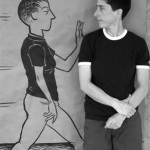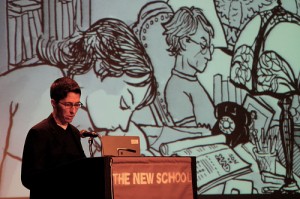Like Fun Home, Asterios Polyp is chock full of allusions, but here they vary a lot more in subtlety. For instance, in the second chapter you have a frame of Asterios as a boy in his bedroom. The titles of two books on his shelves are explicit: The Prince and the Pauper and The Man in the Iron Mask. However, the reader must bring in outside knowledge to grasp the connection to twins and duality. The two posters on the wall present an opposite sort of allusion: the reference to twins and duality is apparent in the image, but you have to work backwards to get put them in context—one is of Tweedle Dee and Tweedle Dum, the other from the myth of Romulus and Remus. Of course, the latter instance is particularly relevant, because on the next page we learn that Asterios’s twin brother died in the womb, and when Asterios confides this to Hana, he speculates as to whether he “somehow suffocated the poor bastard,” as Romulus killed his own twin.
As an aside, in this panel we also have the DNA on the bed (related to the genetic equivalence of twins) contrasted with the molecular pattern on the curtains, we have the black and white duality in the chessboard, and we have in the window the little airplane that appears in the dream sequences with Ignatius. Apparently, there’s a lot of Freudian stuff going on with a kid who has this stuff in his room and doesn’t yet know he has a dead twin brother.
Perhaps owing to Asterios’s heritage, we get a lot of Greek myth. Maybe the most important is the dichotomy between Apollo and Dionysus, which comes up explicitly, with a Greek vase contrasted with an amorphous blob, in Ignatius’s chapter beginning “ABSTRACTIONS.” On the next page, we see Asterios give several of his own interpretations of this famous binary pair, and then with the tipping of the scale we see his clear predilection for the Apollonian—the logical, the functional, the ordered—over Dionysian decoration, passion, and chaos. This is cemented by allusions shortly after to Hesse’s Narcissus and Goldmund and Calvino’s Cloven Viscount (and references to the titles of other pertinent works, including those the two from Asterios’s childhood bedroom) that Ignatius follows with the metafictional quip, “Some might argue that such simplification is best suited to children’s stories, or comic books.” Asterios, attached to his “convenient organizing principle” of duality, disagrees.
Also, his full surname, bastardized at Ellis Island, must have been Polyphemus—later on, he loses his eye and has to wear a patch, effectively making him a Cyclops. I found this interesting, because it hints at his one-sided, narrow approach to logically reducing everything down to polarity—but at this point in the story, he’s near the end of his transformative journey, and he’s changed. And Ignatius tells us his brother always preferred the Greek gods to an solitary, omniscient god because “by giving them human personalities, the ancient Greeks could feel that the world made sense.” Then we see Zeus cavalierly frying some poor guy with a lightning bolt, saying to his buddies, “watch this.” This section I found particularly powerful because it relates to the chaotic events that jar Asterios’s well constructed, functional life: the lightning bolt setting his building on fire, the random violence that costs him his eye, the car crash, and of course, the meteor. As if, the only way to make sense of life is to attribute human capriciousness to fate.
I’ve hardly touched on most of the allusions in the book (Orpheus, anyone? That’s a whole new post), but going back, it’s amazing how interconnected and thematically consistent they are.



